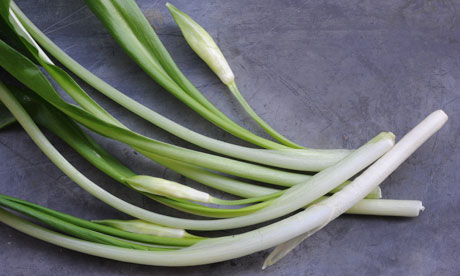
The sight and smell of clumps of wild garlic leaves, or ramsons, going a-begging in the woods, is cause for celebration. As an early standard bearer for the year's crop of fresh green herbs, this first flush of greenness sits up and positively begs to be devoured.
When wild garlic arrives, it's time to dump those stale old bulbs of over-stored, powdery garlic and imported herbs. Why shell out for meagre packs of floppy imported basil when you can make a sublime pesto with a sack load of wild garlic leaves you picked for free? And you can rely on their mellow taste and gentle aroma to bring welcome variation to salads, build flavour in soups and make a perky last-minute garnish for savoury dishes. Eat the pretty white flowers too.
Why is wild garlic good for me?
Given its antibacterial, antibiotic, antiseptic and anti ... well, just about everything, properties, it makes sense to pack as much into your diet as you can. The headline health benefit of garlic is its effectiveness in reducing blood pressure and, hence, heart disease and the risk of stroke. Although all garlic has this property, wild garlic has the greatest effect on lowering blood pressure.
Where to find wild garlic
Wild garlic grows in early spring in weed-like abundance in woods and even in unpromising-looking urban green spaces, filling the air with its aroma. Its sword-shaped, silky, moist leaves resemble those of Lily of the Valley, so rub a leaf between your fingers to make sure that it releases the characteristic garlicky smell. Foraging for wild garlic adds culinary purpose to a Sunday stroll, but you'll also find it cheapish (£1-2 for a 100g bag) on farmers' market stalls.
• Joanna Blythman is the author of What To Eat (Fourth Estate, £9.99). To order a copy for £7.99 with free UK p&p, go to guardianbookshop.co.uk
Toasted linguine with wild garlic
Toasting pasta gives it a nutty flavour that perfectly suits wild garlic, and in this recipe complements the toasted almonds. When it isn't in season, use a few cloves of finely sliced garlic and a handful of chopped parsley.
Serves 4
400g linguine, snapped in half
3 tbsp olive oil
20g butter
3 large red onions, peeled and finely sliced
1 tbsp white wine vinegar
100ml white wine or dry cider
200g wild garlic, trimmed, washed and shredded
40g raisins, soaked in boiling water for 10 minutes
40g blanched whole almonds, toasted and roughly chopped
60g parmesan, grated
Salt and black pepper
1 Preheat the oven to 170C/325F/gas mark 3. Put the linguine on an oven tray, sprinkle 1 tbsp olive oil and rub into the pasta. Spread it out into an even layer and bake for 10 minutes.
2 Give the tray a good shake, turn it round and do it again. By now the pasta should be a rich, golden brown.
3 Meanwhile, put the rest of the olive oil and the butter in a heavy-based pan with a lid, add the onions and bring them up to a sizzle. Add a pinch of salt, pop the lid on and turn it right down.
4 Leave the onions to soften for 10 minutes. Once meltingly soft, take the lid off, turn the heat up and add the vinegar and wine. Simmer until the liquid has nearly evaporated. Throw in the wild garlic, put the lid on again and leave it to wilt for a few minutes.
5 When the pasta is toasted, add it to a pan of boiling water and cook for 7-10 minutes, bearing in mind it will take a little longer than usual. Add the raisins, stir and taste for seasoning.
6 Drain the pasta, return to the pan and tip in the dressing. Mix thoroughly, check the seasoning, add the almonds and pile on to plates with parmesan.
• Rosie Sykes is head chef of Fitzbillies and co-author of The Kitchen Revolution (Ebury Press, £27.50). To order a copy for £19.99 with free UK p&p, go to guardianbookshop.co.uk

